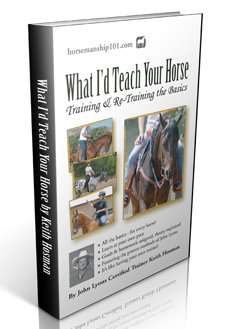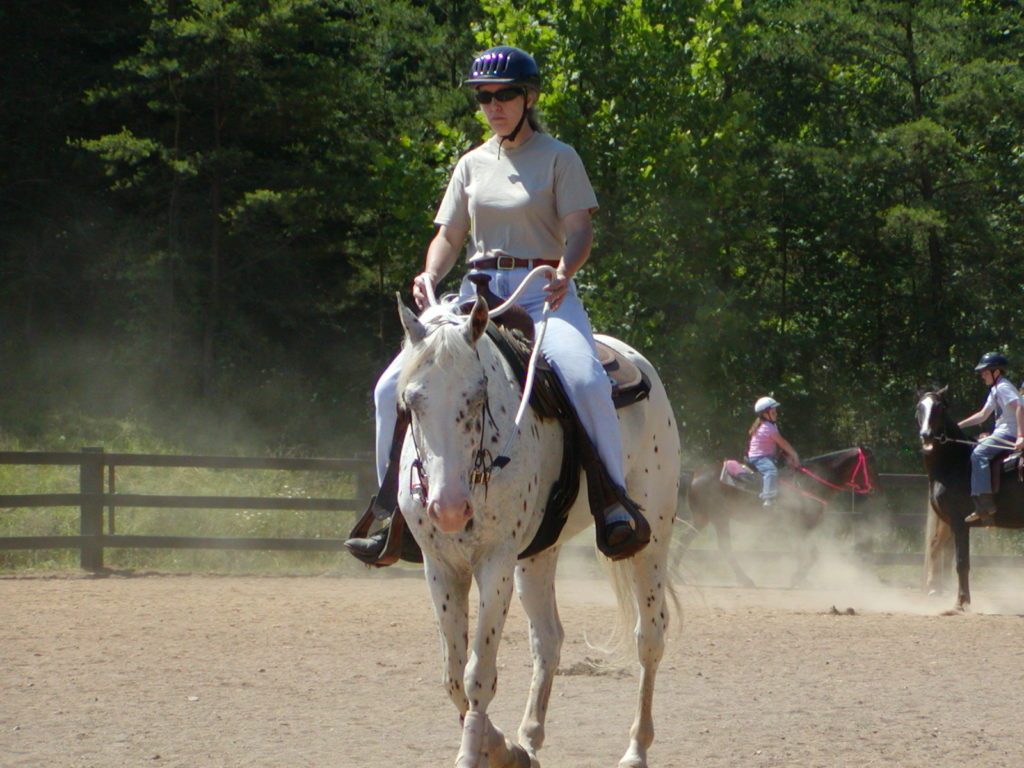Getting Leads | By Keith Hosman
In time, you will teach your horse that dropping your left leg back and pressing the horse's side means (is a cue for) "pick up your right lead." In the interim, with a young horse, you will first position it, then add speed. You will simultaneously apply your cue to teach the cue through association - but in the beginning you must set the horse up so that it "can't help but" end up in the lead you want. Instructions can be made as complicated as you can imagine, but if you keep the following in mind, you'll find this rather simple: To get your right lead, you need to position the horse with it's hind end slightly to the right, ask the horse to speed up, and cue.
First, ask the horse to trot then ask the feet/body positioning to mimic the lead you'd like to pick up. There are at least a dozen ways to properly position your horse to pick up a lead. The simplest is to ask for a "lousy" sidepass: For a left lead, pick up your left rein and ask the horse to move his entire body to the right, allowing the hips to slightly trail to the left, trailing the shoulders by just a bit. Keep a very slight bend in the horse's neck, bent toward the left in this case (this will help keep his shoulders correctly positioned). Squeeze evenly with both legs and kiss. If your horse stays soft and in the position you've created as it moves off, it'll pick up the correct lead. (Note that if you allow the hips to drag too much to one side, the horse will actually be positioned to pick up the wrong lead. Don't allow the hip to be offset by more than a few inches.)
If the horse doesn't get the correct lead, let him travel for a couple of beats before slowing back to a trot and trying again. To chastise more emphatically, you can stop and back several steps before moving forward and trying again. Reprimanding him for the correct lead harshly will not teach him that he got the wrong lead - it'll teach him to fear the departure. If he continually jumps off incorrectly, go back and practice getting soft, resistance-free transitions from a stop to a walk, walk to trot. Add a new wrinkle: Practice your transitions, using but a single rein, asking the horse to move at an angle into the next gait, (moving diagonally), practicing both speeding up and slowing down. This will soften the horse quickly - but also teach it to position itself properly and become more animated. Be careful to get this movement with one rein, not two.
If the horse begins cross-firing, that is, he's loping with his front feet on a different "lead" than the back, pick up and apply pressure to your outside rein. If you're traveling to the left and you feel like your horse has had a blow-out, your body getting thrown roughly to and fro like sitting on an unbalanced washing machine in the spin cycle, he's cross-firing. Pick up your right rein and ask the hips to step over to the left to get the horse to "synch back up." Alternatively, you can also ask the horse to stop, back a few steps, then try again. Simply giving the horse a chance to reposition itself and try again like this may be all it takes.
Teaching the young horse to pick up the correct lead (any horse, really) is ninety percent "softening" through its transitions. The rest is "positioning." Position the horse to step off properly - keep it relaxed through the transition - and nine times out of ten you'll get - and keep - the correct lead. Practice those lift-offs again and again - and sooner rather than later, you will have a horse that nails every departure from a simple cue.
Tip: If I was you - and I really wanted to nail my lead departures - I'd practice the "Three Step Stop Exercise" first. Read it when you click here.
Alternatively, if you've trained the horse to bring its haunches over, ("in"), you can ask the hips to step to the left, apply impulsion - and pick up your left lead. Or, you can ask the shoulders to step right, leaving the hips skewed to the left, apply impulsion and pick up your left lead. You can circle tightly to the left, apply impulsion, pick up your left lead. Trot up to a fence (on your left) at an angle (about 45), then direct-rein the horse sharply back to the left along the fence, adding a kiss, cue and impulsion and you'll take up your left lead. Anything that causes the hips to become positioned just slightly to the left of the shoulders will get you a left lead and vice-versa.
If the horse gets the correct lead, pet him, travel four beats forward, then bring him back to a trot. Calm the horse and yourself, slowly take up the reins and ask again. For twenty minutes, practice only your setups and departures. At first, you'll feel like a can a paint being mixed at the local hardware store - but he'll soon smooth out. Horses best learn to lope - and to get into the lope - by practicing their take off - not so much by traveling around in infinite circles. Yes, they gain physically from the exercise of carrying you around (learning better balance and developing lungs and muscle memory) so loping per se should have a place in your training schedule - but practicing actual departures is where you need to spend your time at the outset. The actual change from trotting to loping, the transition itself, forces the horse to consider what actions he must take to carry the both of you, the cue and what it means, the leg pattern, the shape he travels in, the balanced required. It keeps his mind focused, chewing over the task at hand. What do you get when he simply runs in a circle? Ten seconds after you begin, he's thinking about his buddy in the other paddock, the gate, the barking dog or a million-and-one other things.
Note that every horse is different, bringing to the table a different mix of emotions. Some will settle down more readily when your emphasis is placed upon repeated lead departures as outline. Others will do best when you get them into the lope and leave them there, allowing them to settle in and relax. Nothing is sacrosanct; experiment to see which training cocktail works for your rider/horse combination.
The article above is an excerpt from my book "What I'd Teach Your Horse: Training & Re-Training the Basics."
https://likehorseman.com/getting-leads

"What I'd Teach Your Horse"
Basic Training for Every Horse
If you broke your horse to saddle and rode it for the first time today, this book is where you'd start tomorrow. Likewise, if you have an older horse that needs re-training, you'd start here. This book is a roadmap to building the foundation every horse needs, regardless of age, breed or background, regardless the type of riding for which it will eventually be used.
Get it now: eBook, paperback & even audio!
Click for iBook, Kobo & Nook | Google Play | Kindle | Paperback
Or get it on audio with immediate download:
Amazon | Audible | iTunes

